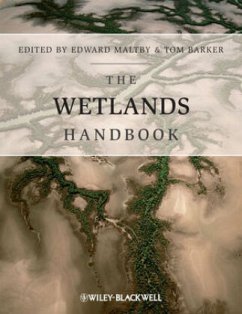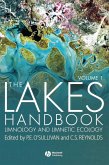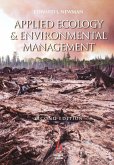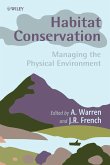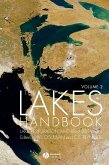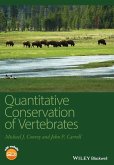- Gebundenes Buch
- Merkliste
- Auf die Merkliste
- Bewerten Bewerten
- Teilen
- Produkt teilen
- Produkterinnerung
- Produkterinnerung
The Wetlands Handbook is a comprehensive analysis aimed at placing the care and understanding of wetlands more firmly at the heart of environmental management. A departure from more traditional scientific treatises on wetland ecosystems, the title adopts a functional approach with a focus on freshwater wetlands.
Forty-two chapters by international experts from a wide range of disciplines make The Wetlands Handbook the essential tool for those seeking comprehensive understanding of the subject. A departure from more traditional treatises, this text examines freshwater wetland ecosystem…mehr
Andere Kunden interessierten sich auch für
![The Lakes Handbook, Volume 1 The Lakes Handbook, Volume 1]() Patrick O'Sullivan / Colin Reynolds (eds.)The Lakes Handbook, Volume 1405,99 €
Patrick O'Sullivan / Colin Reynolds (eds.)The Lakes Handbook, Volume 1405,99 €![Applied Urban Ecology Applied Urban Ecology]() Applied Urban Ecology102,99 €
Applied Urban Ecology102,99 €![Applied Urban Ecology Applied Urban Ecology]() Applied Urban Ecology177,99 €
Applied Urban Ecology177,99 €![Applied Ecology and Environmental 2e Applied Ecology and Environmental 2e]() Edward I. NewmanApplied Ecology and Environmental 2e154,99 €
Edward I. NewmanApplied Ecology and Environmental 2e154,99 €![Habitat Conservation Habitat Conservation]() A. Warren / J. R. French (Hgg.)Habitat Conservation147,99 €
A. Warren / J. R. French (Hgg.)Habitat Conservation147,99 €![The Lakes Handbook, Volume 2 The Lakes Handbook, Volume 2]() OSULLIVAN PADDYREYNOLDS COLIN / O'SULLIVAN E PATRICKThe Lakes Handbook, Volume 2419,99 €
OSULLIVAN PADDYREYNOLDS COLIN / O'SULLIVAN E PATRICKThe Lakes Handbook, Volume 2419,99 €![Quantitative Conservation of Vertebrates Quantitative Conservation of Vertebrates]() Michael J. ConroyQuantitative Conservation of Vertebrates112,99 €
Michael J. ConroyQuantitative Conservation of Vertebrates112,99 €-
-
-
The Wetlands Handbook is a comprehensive analysis aimed at placing the care and understanding of wetlands more firmly at the heart of environmental management. A departure from more traditional scientific treatises on wetland ecosystems, the title adopts a functional approach with a focus on freshwater wetlands.
Forty-two chapters by international experts from a wide range of disciplines make The Wetlands Handbook the essential tool for those seeking comprehensive understanding of the subject. A departure from more traditional treatises, this text examines freshwater wetland ecosystem science from the fundamentals to issues of management and policy.
Introductory chapters address the scope and significance of wetlands globally for communities, culture and biodiversity. Subsequent sections deal with processes underpinning wetland functioning, how wetlands work, their uses and values for humans and nature, their sensitivity to external impacts, and how they may be restored. The text is illustrated by numerous examples, emphasising functional and holistic approaches to wetland management, including case studies on the wise use and rehabilitation of wetlands in farmed, urban, industrial and other damaged environments, highlighting the long-term benefits of multiple use. The Wetlands Handbook will provide an invaluable reference for researchers, managers, policy-makers and students of wetland sciences.
Hinweis: Dieser Artikel kann nur an eine deutsche Lieferadresse ausgeliefert werden.
Forty-two chapters by international experts from a wide range of disciplines make The Wetlands Handbook the essential tool for those seeking comprehensive understanding of the subject. A departure from more traditional treatises, this text examines freshwater wetland ecosystem science from the fundamentals to issues of management and policy.
Introductory chapters address the scope and significance of wetlands globally for communities, culture and biodiversity. Subsequent sections deal with processes underpinning wetland functioning, how wetlands work, their uses and values for humans and nature, their sensitivity to external impacts, and how they may be restored. The text is illustrated by numerous examples, emphasising functional and holistic approaches to wetland management, including case studies on the wise use and rehabilitation of wetlands in farmed, urban, industrial and other damaged environments, highlighting the long-term benefits of multiple use. The Wetlands Handbook will provide an invaluable reference for researchers, managers, policy-makers and students of wetland sciences.
Hinweis: Dieser Artikel kann nur an eine deutsche Lieferadresse ausgeliefert werden.
Produktdetails
- Produktdetails
- Verlag: Blackwell Publishers
- Artikelnr. des Verlages: 1A632052550
- 1. Auflage
- Seitenzahl: 1072
- Erscheinungstermin: 1. Oktober 2009
- Englisch
- Abmessung: 256mm x 202mm x 60mm
- Gewicht: 2495g
- ISBN-13: 9780632052554
- ISBN-10: 0632052554
- Artikelnr.: 21067238
- Herstellerkennzeichnung
- Libri GmbH
- Europaallee 1
- 36244 Bad Hersfeld
- gpsr@libri.de
- Verlag: Blackwell Publishers
- Artikelnr. des Verlages: 1A632052550
- 1. Auflage
- Seitenzahl: 1072
- Erscheinungstermin: 1. Oktober 2009
- Englisch
- Abmessung: 256mm x 202mm x 60mm
- Gewicht: 2495g
- ISBN-13: 9780632052554
- ISBN-10: 0632052554
- Artikelnr.: 21067238
- Herstellerkennzeichnung
- Libri GmbH
- Europaallee 1
- 36244 Bad Hersfeld
- gpsr@libri.de
Edward Maltby is Professor of Wetland Science, Water and Ecosystem Management and Director of the Institute for Sustainable Water, Integrated Management and Ecosystem Research (SWIMMER) at the University of Liverpool, UK. Tom Barker is an ecologist at SWIMMER specialising in catchment relationships with ecosystems, including carbon sequestration and physico-chemical dynamics, particularly in lakes and wetlands.
Preface.
Contributors.
SECTION I WETLANDS IN THE GLOBAL ENVIRONMENT.
1 The Changing Wetland Paradigm (Edward Maltby).
2 Global Distribution, Diversity and Human Alterations of Wetland Resources
(Dennis F. Whigham).
3 Biodiversity in Wetlands (Brij Gopal).
4 Peat as an Archive of Atmospheric, Climatic and Environmental Conditions
(R. Kelman Wieder, Merritt R. Turetsky and Melanie A. Vile).
SECTION II WETLANDS IN THE NATURAL ENVIRONMENT: HOW DO WETLANDS WORK?
5 Introduction - The Dynamics of Wetlands (Tom Barker and Edward Maltby).
6 Hydrological Dynamics I: Surface Waters, Flood and Sediment Dynamics (
Chris Baker, Julian R. Thompson and Matthew Simpson).
7 Hydrological Dynamics II: Groundwater and Hydrological Connectivity (
Dave J. Gilvear and Chris Bradley).
8 Hydrological Dynamics III: Hydro-ecology (Ab P. Grootjans and Rudy Van
Diggelen).
9 Biogeochemical Dynamics I: Nitrogen Cycling in Wetlands (John R. White
and K.R. Reddy).
10 Biogeochemical Dynamics II: Cycling and Storage of Phosphorus in
Wetlands (Curtis J. Richardson and Panchabi Vaithiyanathan).
11 Biogeochemical Dynamics III: The Critical Role of Carbon in Wetlands (
Nancy B. Dise).
12 Wetland Biogeochemical Cycles and their Interactions (Jos T.A. Verhoeven
).
13 Ecological Dynamics I: Vegetation as Bioindicator and Dynamic Community
(Bernard Clément and Michael C.F. Proctor).
14 Ecological Dynamics II: The Infl uences of Vertebrate Herbivory on
Ecological Dynamics in Wetland Ecosystems (Isabel J.J. Van Den Wyngaert and
Roland Bobbink).
15 Ecological Dynamics III: Decomposition in Wetlands (Scott D. Bridgham
and Gary A. Lamberti).
SECTION III WETLANDS IN THE HUMAN ENVIRONMENT: HOW CAN WE UTILISE THE WORK
OF WETLANDS?
16 Introduction - Using Wetland Functioning (Tom Barker and Edward
MaltbyI0.
17 Wetlands and Water Resources (Matthew P. McCartney and Michael C.
Acreman).
18 Wetland and Floodplain Soils: Their Characteristics, Management and
Future (Hadrian F. Cook, Samuel A.F. Bonnett and Leendert J. Pons).
19 The Role of Buffer Zones for Agricultural Runoff (Martin S.A. Blackwell,
David V. Hogan, Gilles Pinay and Edward Maltby).
20 Wetlands for Contaminant and Wastewater Treatment (Robert H. Kadlec).
SECTION IV WETLAND ASSESSMENT: HOW CAN WE MEASURE THAT WETLANDS ARE
WORKING?
21 Introduction - Methodologies for Wetland Assessment (Joseph S. Larson).
22 The United States HGM (Hydrogeomorphic) Approach (Mark M. Brinson).
23 Development of a European Methodology for the Functional Assessment of
Wetlands (Edward Maltby, Tom Barker and Conor Linstead).
24 Wetlands Assessment in Practice: Development and Application in the
United States Regulatory Context (R. Daniel Smith).
25 Wetland Evaluation in Developing Countries (Henri Roggeri).
26 Methodologies for Economic Evaluation of Wetlands and Wetland
Functioning (R. Kerry Turner, Roy Brouwer and S. Georgiou).
SECTION V WETLAND DYSFUNCTIONING: WHAT HAPPENS WHEN WETLANDS DO NOT WORK?
27 Introduction - How Do Wetlands Fail? (Katherine C. Ewel).
28 Hydrological Impacts in and around Wetlands (Michael C. Acreman and
Matthew P. McCartney).
29 Biotic Pressures and Their Effects on Wetland Functioning (C. Max
Finlayson).
30 Human Impacts: Farming, Fire, Forestry and Fuel (Hans Joosten).
SECTION VI WETLAND RESTORATION: MAKING WETLANDS WORK AGAIN.
31 Introduction - Re-establishment of Wetland Functioning (Edward Maltby).
32 Restoration of Wetland Environments: Lessons and Successes (Arnold G.
van der Valk).
33 Replumbing Wetlands - Managing Water for the Restoration of Bogs and
Fens (Russ P. Money, Bryan D. Wheeler, Andy J. Baird and A. Louise
Heathwaitei).
34 Restoring Wetlands for Wildlife Habitat (Dieter Ramseier, Frank Klötzli,
Ursula Bollens and Jörg Pfadenhauer).
35 Wetland Conditions and Requirements for Maintaining Economically
Valuable Species: Waterfowl, Furbearers, Fish and Plants (Lisette C.M. Ross
and Henry R. Murkin).
SECTION VII SUSTAINABLE UTILISATION OF WETLANDS: BALANCING ECOSYSTEM
FUNCTIONING AND HUMAN NEEDS.
36 Introduction - Sustainable Wetlands in a Global Context (Tom Barker).
37 Melaleuca Wetlands and Sustainable Development in the Mekong Delta,
Vietnam (R.J. Safford, Edward Maltby, Duong Van Ni and Nick P. Branch).
38 Multiple Use of Wetlands in Eastern Africa (Reint Jacob Bakema, Geoffrey
W. Howard and Adrian P. Wood).
39 Deterioration and Rehabilitation of the Lower Danube Wetlands System (
Angheluta Vadineanu).
40 The Pantanal of Mato Grosso: Linking Ecological Research, Actual Use and
Management for Sustainable Development (Wolfgang J. Junk, Carolina J. Da
Silva, Karl Matthias Wantzen, Catia Nunes da Cunha and Flavia Nogueira).
41 Wetlands for conservation and recreation use in the Norfolk and Suffolk
Broads (Tom Barker, Steve Crooks and Johan Schutten).
42 Everglades and Agriculture in South Florida (Robert H. Kadlec).
43 Conclusions: Wetlands for the Future (Edward Maltby and Tom Barker).
Glossary.
Index.
Contributors.
SECTION I WETLANDS IN THE GLOBAL ENVIRONMENT.
1 The Changing Wetland Paradigm (Edward Maltby).
2 Global Distribution, Diversity and Human Alterations of Wetland Resources
(Dennis F. Whigham).
3 Biodiversity in Wetlands (Brij Gopal).
4 Peat as an Archive of Atmospheric, Climatic and Environmental Conditions
(R. Kelman Wieder, Merritt R. Turetsky and Melanie A. Vile).
SECTION II WETLANDS IN THE NATURAL ENVIRONMENT: HOW DO WETLANDS WORK?
5 Introduction - The Dynamics of Wetlands (Tom Barker and Edward Maltby).
6 Hydrological Dynamics I: Surface Waters, Flood and Sediment Dynamics (
Chris Baker, Julian R. Thompson and Matthew Simpson).
7 Hydrological Dynamics II: Groundwater and Hydrological Connectivity (
Dave J. Gilvear and Chris Bradley).
8 Hydrological Dynamics III: Hydro-ecology (Ab P. Grootjans and Rudy Van
Diggelen).
9 Biogeochemical Dynamics I: Nitrogen Cycling in Wetlands (John R. White
and K.R. Reddy).
10 Biogeochemical Dynamics II: Cycling and Storage of Phosphorus in
Wetlands (Curtis J. Richardson and Panchabi Vaithiyanathan).
11 Biogeochemical Dynamics III: The Critical Role of Carbon in Wetlands (
Nancy B. Dise).
12 Wetland Biogeochemical Cycles and their Interactions (Jos T.A. Verhoeven
).
13 Ecological Dynamics I: Vegetation as Bioindicator and Dynamic Community
(Bernard Clément and Michael C.F. Proctor).
14 Ecological Dynamics II: The Infl uences of Vertebrate Herbivory on
Ecological Dynamics in Wetland Ecosystems (Isabel J.J. Van Den Wyngaert and
Roland Bobbink).
15 Ecological Dynamics III: Decomposition in Wetlands (Scott D. Bridgham
and Gary A. Lamberti).
SECTION III WETLANDS IN THE HUMAN ENVIRONMENT: HOW CAN WE UTILISE THE WORK
OF WETLANDS?
16 Introduction - Using Wetland Functioning (Tom Barker and Edward
MaltbyI0.
17 Wetlands and Water Resources (Matthew P. McCartney and Michael C.
Acreman).
18 Wetland and Floodplain Soils: Their Characteristics, Management and
Future (Hadrian F. Cook, Samuel A.F. Bonnett and Leendert J. Pons).
19 The Role of Buffer Zones for Agricultural Runoff (Martin S.A. Blackwell,
David V. Hogan, Gilles Pinay and Edward Maltby).
20 Wetlands for Contaminant and Wastewater Treatment (Robert H. Kadlec).
SECTION IV WETLAND ASSESSMENT: HOW CAN WE MEASURE THAT WETLANDS ARE
WORKING?
21 Introduction - Methodologies for Wetland Assessment (Joseph S. Larson).
22 The United States HGM (Hydrogeomorphic) Approach (Mark M. Brinson).
23 Development of a European Methodology for the Functional Assessment of
Wetlands (Edward Maltby, Tom Barker and Conor Linstead).
24 Wetlands Assessment in Practice: Development and Application in the
United States Regulatory Context (R. Daniel Smith).
25 Wetland Evaluation in Developing Countries (Henri Roggeri).
26 Methodologies for Economic Evaluation of Wetlands and Wetland
Functioning (R. Kerry Turner, Roy Brouwer and S. Georgiou).
SECTION V WETLAND DYSFUNCTIONING: WHAT HAPPENS WHEN WETLANDS DO NOT WORK?
27 Introduction - How Do Wetlands Fail? (Katherine C. Ewel).
28 Hydrological Impacts in and around Wetlands (Michael C. Acreman and
Matthew P. McCartney).
29 Biotic Pressures and Their Effects on Wetland Functioning (C. Max
Finlayson).
30 Human Impacts: Farming, Fire, Forestry and Fuel (Hans Joosten).
SECTION VI WETLAND RESTORATION: MAKING WETLANDS WORK AGAIN.
31 Introduction - Re-establishment of Wetland Functioning (Edward Maltby).
32 Restoration of Wetland Environments: Lessons and Successes (Arnold G.
van der Valk).
33 Replumbing Wetlands - Managing Water for the Restoration of Bogs and
Fens (Russ P. Money, Bryan D. Wheeler, Andy J. Baird and A. Louise
Heathwaitei).
34 Restoring Wetlands for Wildlife Habitat (Dieter Ramseier, Frank Klötzli,
Ursula Bollens and Jörg Pfadenhauer).
35 Wetland Conditions and Requirements for Maintaining Economically
Valuable Species: Waterfowl, Furbearers, Fish and Plants (Lisette C.M. Ross
and Henry R. Murkin).
SECTION VII SUSTAINABLE UTILISATION OF WETLANDS: BALANCING ECOSYSTEM
FUNCTIONING AND HUMAN NEEDS.
36 Introduction - Sustainable Wetlands in a Global Context (Tom Barker).
37 Melaleuca Wetlands and Sustainable Development in the Mekong Delta,
Vietnam (R.J. Safford, Edward Maltby, Duong Van Ni and Nick P. Branch).
38 Multiple Use of Wetlands in Eastern Africa (Reint Jacob Bakema, Geoffrey
W. Howard and Adrian P. Wood).
39 Deterioration and Rehabilitation of the Lower Danube Wetlands System (
Angheluta Vadineanu).
40 The Pantanal of Mato Grosso: Linking Ecological Research, Actual Use and
Management for Sustainable Development (Wolfgang J. Junk, Carolina J. Da
Silva, Karl Matthias Wantzen, Catia Nunes da Cunha and Flavia Nogueira).
41 Wetlands for conservation and recreation use in the Norfolk and Suffolk
Broads (Tom Barker, Steve Crooks and Johan Schutten).
42 Everglades and Agriculture in South Florida (Robert H. Kadlec).
43 Conclusions: Wetlands for the Future (Edward Maltby and Tom Barker).
Glossary.
Index.
Preface.
Contributors.
SECTION I WETLANDS IN THE GLOBAL ENVIRONMENT.
1 The Changing Wetland Paradigm (Edward Maltby).
2 Global Distribution, Diversity and Human Alterations of Wetland Resources
(Dennis F. Whigham).
3 Biodiversity in Wetlands (Brij Gopal).
4 Peat as an Archive of Atmospheric, Climatic and Environmental Conditions
(R. Kelman Wieder, Merritt R. Turetsky and Melanie A. Vile).
SECTION II WETLANDS IN THE NATURAL ENVIRONMENT: HOW DO WETLANDS WORK?
5 Introduction - The Dynamics of Wetlands (Tom Barker and Edward Maltby).
6 Hydrological Dynamics I: Surface Waters, Flood and Sediment Dynamics (
Chris Baker, Julian R. Thompson and Matthew Simpson).
7 Hydrological Dynamics II: Groundwater and Hydrological Connectivity (
Dave J. Gilvear and Chris Bradley).
8 Hydrological Dynamics III: Hydro-ecology (Ab P. Grootjans and Rudy Van
Diggelen).
9 Biogeochemical Dynamics I: Nitrogen Cycling in Wetlands (John R. White
and K.R. Reddy).
10 Biogeochemical Dynamics II: Cycling and Storage of Phosphorus in
Wetlands (Curtis J. Richardson and Panchabi Vaithiyanathan).
11 Biogeochemical Dynamics III: The Critical Role of Carbon in Wetlands (
Nancy B. Dise).
12 Wetland Biogeochemical Cycles and their Interactions (Jos T.A. Verhoeven
).
13 Ecological Dynamics I: Vegetation as Bioindicator and Dynamic Community
(Bernard Clément and Michael C.F. Proctor).
14 Ecological Dynamics II: The Infl uences of Vertebrate Herbivory on
Ecological Dynamics in Wetland Ecosystems (Isabel J.J. Van Den Wyngaert and
Roland Bobbink).
15 Ecological Dynamics III: Decomposition in Wetlands (Scott D. Bridgham
and Gary A. Lamberti).
SECTION III WETLANDS IN THE HUMAN ENVIRONMENT: HOW CAN WE UTILISE THE WORK
OF WETLANDS?
16 Introduction - Using Wetland Functioning (Tom Barker and Edward
MaltbyI0.
17 Wetlands and Water Resources (Matthew P. McCartney and Michael C.
Acreman).
18 Wetland and Floodplain Soils: Their Characteristics, Management and
Future (Hadrian F. Cook, Samuel A.F. Bonnett and Leendert J. Pons).
19 The Role of Buffer Zones for Agricultural Runoff (Martin S.A. Blackwell,
David V. Hogan, Gilles Pinay and Edward Maltby).
20 Wetlands for Contaminant and Wastewater Treatment (Robert H. Kadlec).
SECTION IV WETLAND ASSESSMENT: HOW CAN WE MEASURE THAT WETLANDS ARE
WORKING?
21 Introduction - Methodologies for Wetland Assessment (Joseph S. Larson).
22 The United States HGM (Hydrogeomorphic) Approach (Mark M. Brinson).
23 Development of a European Methodology for the Functional Assessment of
Wetlands (Edward Maltby, Tom Barker and Conor Linstead).
24 Wetlands Assessment in Practice: Development and Application in the
United States Regulatory Context (R. Daniel Smith).
25 Wetland Evaluation in Developing Countries (Henri Roggeri).
26 Methodologies for Economic Evaluation of Wetlands and Wetland
Functioning (R. Kerry Turner, Roy Brouwer and S. Georgiou).
SECTION V WETLAND DYSFUNCTIONING: WHAT HAPPENS WHEN WETLANDS DO NOT WORK?
27 Introduction - How Do Wetlands Fail? (Katherine C. Ewel).
28 Hydrological Impacts in and around Wetlands (Michael C. Acreman and
Matthew P. McCartney).
29 Biotic Pressures and Their Effects on Wetland Functioning (C. Max
Finlayson).
30 Human Impacts: Farming, Fire, Forestry and Fuel (Hans Joosten).
SECTION VI WETLAND RESTORATION: MAKING WETLANDS WORK AGAIN.
31 Introduction - Re-establishment of Wetland Functioning (Edward Maltby).
32 Restoration of Wetland Environments: Lessons and Successes (Arnold G.
van der Valk).
33 Replumbing Wetlands - Managing Water for the Restoration of Bogs and
Fens (Russ P. Money, Bryan D. Wheeler, Andy J. Baird and A. Louise
Heathwaitei).
34 Restoring Wetlands for Wildlife Habitat (Dieter Ramseier, Frank Klötzli,
Ursula Bollens and Jörg Pfadenhauer).
35 Wetland Conditions and Requirements for Maintaining Economically
Valuable Species: Waterfowl, Furbearers, Fish and Plants (Lisette C.M. Ross
and Henry R. Murkin).
SECTION VII SUSTAINABLE UTILISATION OF WETLANDS: BALANCING ECOSYSTEM
FUNCTIONING AND HUMAN NEEDS.
36 Introduction - Sustainable Wetlands in a Global Context (Tom Barker).
37 Melaleuca Wetlands and Sustainable Development in the Mekong Delta,
Vietnam (R.J. Safford, Edward Maltby, Duong Van Ni and Nick P. Branch).
38 Multiple Use of Wetlands in Eastern Africa (Reint Jacob Bakema, Geoffrey
W. Howard and Adrian P. Wood).
39 Deterioration and Rehabilitation of the Lower Danube Wetlands System (
Angheluta Vadineanu).
40 The Pantanal of Mato Grosso: Linking Ecological Research, Actual Use and
Management for Sustainable Development (Wolfgang J. Junk, Carolina J. Da
Silva, Karl Matthias Wantzen, Catia Nunes da Cunha and Flavia Nogueira).
41 Wetlands for conservation and recreation use in the Norfolk and Suffolk
Broads (Tom Barker, Steve Crooks and Johan Schutten).
42 Everglades and Agriculture in South Florida (Robert H. Kadlec).
43 Conclusions: Wetlands for the Future (Edward Maltby and Tom Barker).
Glossary.
Index.
Contributors.
SECTION I WETLANDS IN THE GLOBAL ENVIRONMENT.
1 The Changing Wetland Paradigm (Edward Maltby).
2 Global Distribution, Diversity and Human Alterations of Wetland Resources
(Dennis F. Whigham).
3 Biodiversity in Wetlands (Brij Gopal).
4 Peat as an Archive of Atmospheric, Climatic and Environmental Conditions
(R. Kelman Wieder, Merritt R. Turetsky and Melanie A. Vile).
SECTION II WETLANDS IN THE NATURAL ENVIRONMENT: HOW DO WETLANDS WORK?
5 Introduction - The Dynamics of Wetlands (Tom Barker and Edward Maltby).
6 Hydrological Dynamics I: Surface Waters, Flood and Sediment Dynamics (
Chris Baker, Julian R. Thompson and Matthew Simpson).
7 Hydrological Dynamics II: Groundwater and Hydrological Connectivity (
Dave J. Gilvear and Chris Bradley).
8 Hydrological Dynamics III: Hydro-ecology (Ab P. Grootjans and Rudy Van
Diggelen).
9 Biogeochemical Dynamics I: Nitrogen Cycling in Wetlands (John R. White
and K.R. Reddy).
10 Biogeochemical Dynamics II: Cycling and Storage of Phosphorus in
Wetlands (Curtis J. Richardson and Panchabi Vaithiyanathan).
11 Biogeochemical Dynamics III: The Critical Role of Carbon in Wetlands (
Nancy B. Dise).
12 Wetland Biogeochemical Cycles and their Interactions (Jos T.A. Verhoeven
).
13 Ecological Dynamics I: Vegetation as Bioindicator and Dynamic Community
(Bernard Clément and Michael C.F. Proctor).
14 Ecological Dynamics II: The Infl uences of Vertebrate Herbivory on
Ecological Dynamics in Wetland Ecosystems (Isabel J.J. Van Den Wyngaert and
Roland Bobbink).
15 Ecological Dynamics III: Decomposition in Wetlands (Scott D. Bridgham
and Gary A. Lamberti).
SECTION III WETLANDS IN THE HUMAN ENVIRONMENT: HOW CAN WE UTILISE THE WORK
OF WETLANDS?
16 Introduction - Using Wetland Functioning (Tom Barker and Edward
MaltbyI0.
17 Wetlands and Water Resources (Matthew P. McCartney and Michael C.
Acreman).
18 Wetland and Floodplain Soils: Their Characteristics, Management and
Future (Hadrian F. Cook, Samuel A.F. Bonnett and Leendert J. Pons).
19 The Role of Buffer Zones for Agricultural Runoff (Martin S.A. Blackwell,
David V. Hogan, Gilles Pinay and Edward Maltby).
20 Wetlands for Contaminant and Wastewater Treatment (Robert H. Kadlec).
SECTION IV WETLAND ASSESSMENT: HOW CAN WE MEASURE THAT WETLANDS ARE
WORKING?
21 Introduction - Methodologies for Wetland Assessment (Joseph S. Larson).
22 The United States HGM (Hydrogeomorphic) Approach (Mark M. Brinson).
23 Development of a European Methodology for the Functional Assessment of
Wetlands (Edward Maltby, Tom Barker and Conor Linstead).
24 Wetlands Assessment in Practice: Development and Application in the
United States Regulatory Context (R. Daniel Smith).
25 Wetland Evaluation in Developing Countries (Henri Roggeri).
26 Methodologies for Economic Evaluation of Wetlands and Wetland
Functioning (R. Kerry Turner, Roy Brouwer and S. Georgiou).
SECTION V WETLAND DYSFUNCTIONING: WHAT HAPPENS WHEN WETLANDS DO NOT WORK?
27 Introduction - How Do Wetlands Fail? (Katherine C. Ewel).
28 Hydrological Impacts in and around Wetlands (Michael C. Acreman and
Matthew P. McCartney).
29 Biotic Pressures and Their Effects on Wetland Functioning (C. Max
Finlayson).
30 Human Impacts: Farming, Fire, Forestry and Fuel (Hans Joosten).
SECTION VI WETLAND RESTORATION: MAKING WETLANDS WORK AGAIN.
31 Introduction - Re-establishment of Wetland Functioning (Edward Maltby).
32 Restoration of Wetland Environments: Lessons and Successes (Arnold G.
van der Valk).
33 Replumbing Wetlands - Managing Water for the Restoration of Bogs and
Fens (Russ P. Money, Bryan D. Wheeler, Andy J. Baird and A. Louise
Heathwaitei).
34 Restoring Wetlands for Wildlife Habitat (Dieter Ramseier, Frank Klötzli,
Ursula Bollens and Jörg Pfadenhauer).
35 Wetland Conditions and Requirements for Maintaining Economically
Valuable Species: Waterfowl, Furbearers, Fish and Plants (Lisette C.M. Ross
and Henry R. Murkin).
SECTION VII SUSTAINABLE UTILISATION OF WETLANDS: BALANCING ECOSYSTEM
FUNCTIONING AND HUMAN NEEDS.
36 Introduction - Sustainable Wetlands in a Global Context (Tom Barker).
37 Melaleuca Wetlands and Sustainable Development in the Mekong Delta,
Vietnam (R.J. Safford, Edward Maltby, Duong Van Ni and Nick P. Branch).
38 Multiple Use of Wetlands in Eastern Africa (Reint Jacob Bakema, Geoffrey
W. Howard and Adrian P. Wood).
39 Deterioration and Rehabilitation of the Lower Danube Wetlands System (
Angheluta Vadineanu).
40 The Pantanal of Mato Grosso: Linking Ecological Research, Actual Use and
Management for Sustainable Development (Wolfgang J. Junk, Carolina J. Da
Silva, Karl Matthias Wantzen, Catia Nunes da Cunha and Flavia Nogueira).
41 Wetlands for conservation and recreation use in the Norfolk and Suffolk
Broads (Tom Barker, Steve Crooks and Johan Schutten).
42 Everglades and Agriculture in South Florida (Robert H. Kadlec).
43 Conclusions: Wetlands for the Future (Edward Maltby and Tom Barker).
Glossary.
Index.

